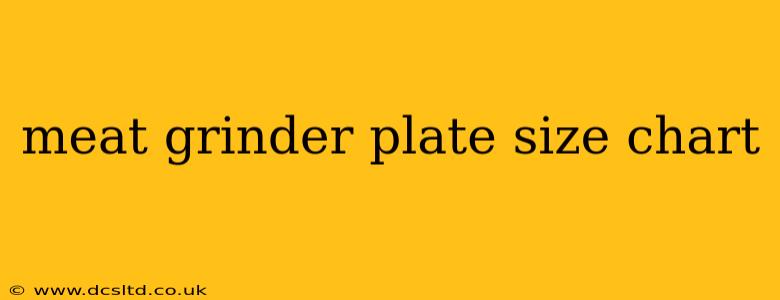Choosing the right plate for your meat grinder can significantly impact the texture and efficiency of your ground meat. This comprehensive guide will help you understand meat grinder plate sizes, their uses, and how to select the perfect plate for your needs. We'll cover different types of plates, their corresponding die holes, and how these affect the final product.
What are Meat Grinder Plates and Why are They Important?
Meat grinder plates, also known as grinding plates or plates, are the crucial components determining the coarseness or fineness of your ground meat. They're circular metal plates with various sized holes, inserted into the grinder's head. The size of these holes directly correlates to the texture of the final ground meat. Larger holes produce coarser ground meat, ideal for sausages or certain types of burgers, while smaller holes create finer ground meat, perfect for things like meatballs or bologna.
Understanding Meat Grinder Plate Sizes and Hole Diameters
Meat grinder plates are typically identified by their hole diameter, often measured in millimeters (mm). A common misconception is that the size refers to the plate's overall diameter; however, the crucial specification is the size of the individual holes. You'll find plates with various hole sizes, each producing a different texture:
-
Large Holes (e.g., 8mm, 10mm): These produce coarse ground meat, suitable for sausages, chili, and applications where larger pieces of meat are desirable. This setting is also often favored for grinding tougher cuts of meat due to less resistance.
-
Medium Holes (e.g., 4mm, 6mm): These create a medium grind, versatile for many recipes. Burgers, meatballs, and some sausage varieties work well with this texture. It offers a good balance between texture and ease of grinding.
-
Small Holes (e.g., 3mm, 2mm): These produce a fine grind, perfect for smooth textures needed in dishes like bologna, pâté, or fine-textured meatballs. This setting requires more power from your grinder and can be more time-consuming.
Common Meat Grinder Plate Sizes: A Quick Reference
While specific sizes vary slightly between manufacturers, here's a general idea of the sizes you're likely to encounter:
| Hole Diameter (mm) | Grind Texture | Typical Uses |
|---|---|---|
| 8-10 | Coarse | Sausages, Chili, Stews |
| 6-7 | Medium | Burgers, Meatballs, Some Sausages |
| 3-5 | Fine | Bologna, Pâté, Smooth Meatballs |
| 2 | Extra Fine | Forcemeats, Smooth spreads, etc |
How to Choose the Right Meat Grinder Plate Size
The best plate size for you depends entirely on your intended use. Consider:
What type of meat will you grind?
Tougher cuts of meat may benefit from larger holes to reduce strain on your grinder.
What are you making?
The desired texture of your final product dictates the appropriate plate size. Fine grinds are ideal for smooth products, while coarser grinds are better for applications where texture is desirable.
What's the power of your meat grinder?
Smaller holes require more power. If you have a less powerful grinder, stick to larger holes to avoid overheating or straining the motor.
Different Types of Meat Grinder Plates: Beyond Hole Size
While hole size is the primary factor, some meat grinder plates offer additional features:
-
Different materials: Plates can be made of stainless steel (most common), cast iron, or other materials. Stainless steel offers durability and easy cleaning.
-
Thickness: Thicker plates tend to be more durable but can also put more strain on your grinder.
-
Additional attachments: Some grinders have extra plates for specific purposes, such as vegetable grinding plates or kibble plates for pet food.
How to Clean Meat Grinder Plates
Cleaning your plates is crucial for hygiene and extending their lifespan. Always follow the manufacturer's instructions, but generally, hot soapy water and a stiff brush work well. Avoid abrasive cleaners that could scratch the surface.
This guide should help you navigate the world of meat grinder plate sizes and choose the perfect plate for your grinding needs. Remember to always consult your grinder's manual for specific recommendations and safety instructions.
